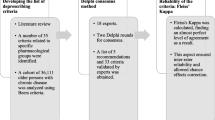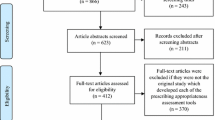Abstract
Potentially inappropriate prescribing for older adults is a major public health concern. While there are multiple measures of potentially inappropriate prescribing, the medication appropriateness index (MAI) is one of the most common implicit approaches published in the scientific literature. The objective of this narrative review is to describe findings regarding the MAI’s reliability, comparison of the MAI with other quality measures of potentially inappropriate prescribing, its predictive validity with important health outcomes, and its responsiveness to change within the framework of randomized controlled trials. A search restricted to English-language literature involving humans aged 65+ years from January 1992 to June 2013 was conducted using MEDLINE and EMBASE databases using the search term ‘medication appropriateness index’. A manual search of the reference lists from identified articles and the authors’ article files, book chapters, and recent reviews was conducted to identify additional articles. A total of 26 articles were identified for inclusion in this narrative review. The main findings were that the MAI has acceptable inter- and intra-rater reliability, it more frequently detects potentially inappropriate prescribing than a commonly used set of explicit criteria, it predicts adverse health outcomes, and it is able to demonstrate the positive impact of interventions to improve this public health problem. We conclude that the MAI may serve as a valuable tool for measuring potentially inappropriate prescribing in older adults.
Similar content being viewed by others
References
Spinewine A, Schmader KE, Barber N, Hughes C, Lapane K, Swine C, et al. Appropriate prescribing in elderly people: how can it be measured and optimized? Lancet. 2007;370:173–84.
Nelson EA, Dannefer D. Aged heterogeneity: fact or fiction? The fate of diversity in gerontological research. Gerontologist. 1992;32:17–23.
Mangoni AA, Jackson SH. Age-related changes in pharmacokinetics and pharmacodynamics: basic principles and practical applications. Br J Clin Pharmacol. 2004;57:6–14.
Hanlon JT, Schmader KE, Ruby CM, Weinberger M. Suboptimal prescribing in elderly inpatients and outpatients. J Am Geriatr Soc. 2001;49:200–9.
Knapp DA. Development of criteria for drug utilization review. Clin Pharmacol Ther. 1991;5:600–2.
Beers MH, Ouslander JG, Rollingher I, Reuben DB, Brooks J, Beck JC. Explicit criteria for determining inappropriate medication use in nursing home residents. Arch Intern Med. 1991;151:1825–32.
Dimitrov MS, Airaksinen MS, Kivelä SL, Lyles A, Leikola SN. Comparison of prescribing criteria to evaluate the appropriateness of drug treatment in individuals aged 65 and older: a systematic review. J Am Geriatr Soc. 2011;59:1521–30.
O’Connor MN, Gallagher P, O’Mahony D. Inappropriate prescribing: criteria, detection and prevention. Drugs Aging. 2012;29:437–52.
Hanlon JT, Schmader K, Lewis I. Adverse drug reactions. In: Delafuente JC, Stewart RB, editors. Therapeutics in the elderly. 2nd ed. Cincinnati: Harvey Whitney Books; 1995. p. 212–27.
Hanlon JT, Schmader KE, Samsa GP, Weinberger M, Uttech KM, Lewis IK, et al. A method for assessing drug therapy appropriateness. J Clin Epidemiol. 1992;45:1045–51.
Samsa G, Hanlon JT, Schmader KE, Weinberger M, Clipp EC, Uttech K, et al. A summated score for the medication appropriateness index: development and assessment of clinimetric properties including content validity. J Clin Epidemiol. 1994;47:891–6.
Hanlon JT, Weinberger M, Samsa GP, Schmader K, Lewis I, Uttech K, et al. A randomized controlled trial of a clinical pharmacist intervention with elderly outpatients with polypharmacy. Am J Med. 1996;100:428–37.
Fitzgerald LS, Hanlon JT, Shelton PS, Landsman PB, Schmader KE, Pulliam CC, Williams ME. Reliability of a modified medication appropriateness index in ambulatory older persons. Ann Pharmacother. 1997;31:543–8.
Kassam R, Martin LG, Farris KB. Reliability of a modified medication appropriateness index in community pharmacies. Ann Pharmacother. 2003;37:40–6.
Bregnhøj L, Thirstrup S, Kristensen MB, Sonne J. Reliability of a modified medication appropriateness index in primary care. Eur J Clin Pharmacol. 2005;61:769–73.
Spinewine A, Dumont C, Mallet L, Swine C. Medication appropriateness index: reliability and recommendations for future use. J Am Geriatr Soc. 2006;54:720–2.
Stuijt CC, Franssen EJ, Egberts AC, Hudson SA. Reliability of the medication appropriateness index in Dutch residential home. Pharm World Sci. 2009;31:380–6.
Gallagher PF, O’Connor MN, O’Mahony D. Prevention of potentially inappropriate prescribing for elderly patients: a randomized controlled trial using STOPP/START criteria. Clin Pharmacol Ther. 2011;89:845–54.
Steinman MA, Rosenthal GE, Landefeld CS, Bertenthal D, Sen S, Kaboli PJ. Conflicts and concordance between measures of medication prescribing quality. Med Care. 2007;45:95–9.
Lund BC, Steinman MA, Chrischilles EA, Kaboli PJ. Beers criteria as a proxy for inappropriate prescribing of other medications among older adults. Ann Pharmacother. 2011;45:1363–70.
Luo R, Scullin C, Mullan AM, Scott MG, McElnay JC. Comparison of tools for the assessment of inappropriate prescribing in hospitalized older people. J Eval Clin Pract. 2012;18:1196–202.
Schmader KE, Hanlon JT, Landsman PB, Samsa GP, Lewis IK, Weinberger M. Inappropriate prescribing and health outcomes in elderly veteran outpatients. Ann Pharmacother. 1997;31:529–33.
Lund BC, Carnahan RM, Egge JA, Chrischilles EA, Kaboli PJ. Inappropriate prescribing predicts adverse drug events in older adults. Ann Pharmacother. 2010;44:957–63.
Hanlon JT, Sloane RJ, Pieper CF, Schmader KE. Association of adverse drug reactions with drug–drug and drug–disease interactions in frail older outpatients. Age Ageing. 2011;40:274–7.
Olsson IN, Runnamo R, Engfeldt P. Medication quality and quality of life in the elderly, a cohort study. Health Qual Life Outcomes. 2011;9:95.
Hellström LM, Bondesson A, Höglund P, Midlöv P, Holmdahl L, et al. Impact of the Lund Integrated Medicines Management (LIMM) model on medication appropriateness and drug-related hospital revisits. Eur J Clin Pharmacol. 2011;67:741–52.
Somers A, Mallet L, van der Cammen T, Robays H, Petrovic M. Applicability of an adapted medication appropriateness index for detection of drug-related problems in geriatric inpatients. Am J Geriatr Pharmacother. 2012;10:101–9.
Gillespie UM, Alassaad A, Hammarlund-Udenaes M, Mörlin C, Henrohn D, Bertilsson M, et al. Effects of pharmacists’ interventions on appropriateness of prescribing and evaluation of the instruments’ (MAI, STOPP and STARTs’) ability to predict hospitalization: analyses from a randomized controlled trial. Plos One. 2013;8:e62401.
Bregnhøj L, Thirstrup S, Kristensen MB, Bjerrum L, Sonne J. Combined intervention programme reduces inappropriate prescribing in elderly patients exposed to polypharmacy in primary care. Eur J Clin Pharmacol. 2009;65:199–207.
Crotty M, Rowett D, Spurling L, Giles LC, Phillips PA. Does the addition of a pharmacist transition coordinator improve evidence-based medication management and health outcomes in older adults moving from the hospital to a long-term care facility? Results of a randomized, controlled trial. Am J Geriatr Pharmacother. 2004;2:257–64.
Bryant LJ, Coster G, Gamble GD, McCormick RN. The General Practitioner–Pharmacist Collaboration (GPPC) study: a randomised controlled trial of clinical medication reviews. Int J of Pharm Pract. 2011;19(2):94–105.
Burnett KM, Scott MG, Fleming GF, Clark CM, McElnay JC. Effects of an integrated medicines management program on medication appropriateness in hospitalized patients. Am J Health Syst Pharm. 2009;66:854–9.
Crotty M, Halbert J, Rowett D, Giles L, Birks R, Williams H, et al. An outreach geriatric medication advisory service in residential aged care: a randomised controlled trial of case conferencing. Age Ageing. 2004;33:612–7.
Schmader KE, Hanlon JT, Pieper CF, Sloane R, Ruby CM, Twersky J, et al. Effects of geriatric evaluation and management on adverse drug reactions and suboptimal prescribing in the frail elderly. Am J Med. 2004;116:394–401.
Spinewine A, Swine C, Dhillon S, Lambert P, Nachega JB, Wilmotte L, et al. Effect of a collaborative approach on the quality of prescribing for geriatric inpatients: a randomized controlled trial. J Am Geriatr Soc. 2007;55:658–65.
Hanlon JT, Schmader KE. What types of inappropriate prescribing predict adverse drug reactions in older adults? Ann Pharmacother. 2010;44:1110–1.
Hamilton HJ, Gallagher PF, O’Mahony D. Inappropriate prescribing and adverse drug events in older people. BMC Geriatr. 2009;9:5.
Hamilton H, Gallagher P, Ryan C, Byrne S, O’Mahony D. Potentially inappropriate medications defined by STOPP criteria and the risk of adverse drug events in older hospitalized patients. Arch Intern Med. 2011;171:1013–9.
Hajjar ER, Hanlon JT, Sloane RJ, Lindblad CI, Pieper CF, Ruby CM, et al. Unnecessary drug use in the frail elderly at hospital discharge. J Am Geriatr Soc. 2005;53:1518–23.
Wright RM, Sloane RJ, Pieper CF, Ruby-Scelsi CM, Twersky J, Schmader KE, et al. Underuse of indicated medications among physically frail older US veterans at the time of hospital discharge. Am J Geriatr Pharmacother. 2009;7:271–80.
Volume CI, Burback LM, Farris KB. Reassessing the MAI: elderly persons opinions about medication appropriateness. Int J Pharm Pract. 1997;3:129–37.
Barber N, Bradley C, Barry C, Stevenson F, Britten N, Jenkins L. Measuring the appropriateness of prescribing in primary care: are current measures complete? J Clin Pharm Ther. 2005;30:533–9.
The American Geriatrics Society. Beers Criteria Update Expert Panel: American Geriatrics Society updated Beers Criteria for potentially inappropriate medication use in older adults. J Am Geriatr Soc. 2012;2012(60):616–31.
Gallagher P, Ryan C, Byrne S, Byrne S, Kennedy J, O’Mahony D. STOPP (Screening Tool of Older Persons’ Prescriptions) and START (Screening Tool to Alert Doctors to Right Treatment): consensus validation. Int J Clin Pharm Ther. 2008;46:72–83.
Holmes HM, Sachs GA, Shega JW, et al. Integrating palliative medicine into the care of persons with advanced dementia: identifying appropriate medication use. J Am Geriatr Soc. 2008;56:1306–11.
Suhrie EM, Hanlon JT, Jaffe EJ, Sevick MA, Ruby CM, Aspinall SL. Impact of a geriatric nursing home palliative care service on unnecessary medication prescribing. Am J Geriatr Pharmacother. 2009;7(1):20–5.
Acknowledgments
Supported in part by the National Institute on Aging Grants (R01-AG 027017, P30-AG024827, K07-AG033174, P30-AG028716), and an Agency for Healthcare Research and Quality Grant (R01-HS018721). The authors report no potential conflicts of interest.
Author information
Authors and Affiliations
Corresponding author
Rights and permissions
About this article
Cite this article
Hanlon, J.T., Schmader, K.E. The Medication Appropriateness Index at 20: Where It Started, Where It Has Been, and Where It May Be Going. Drugs Aging 30, 893–900 (2013). https://doi.org/10.1007/s40266-013-0118-4
Published:
Issue Date:
DOI: https://doi.org/10.1007/s40266-013-0118-4




